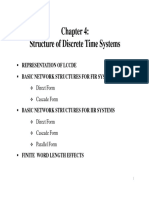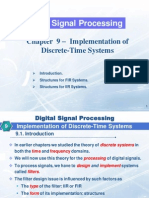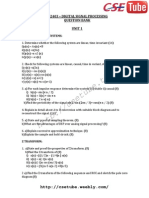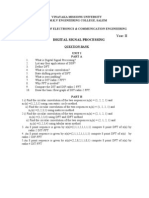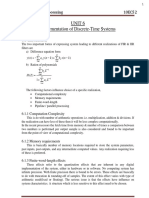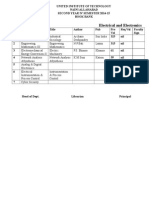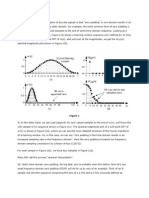Structures For Discrete-Time Systems: Block Diagram and Signal Flow Graph
Uploaded by
Rudra Kumar MishraStructures For Discrete-Time Systems: Block Diagram and Signal Flow Graph
Uploaded by
Rudra Kumar MishraDSP (Spring, 2007)
Structures for Discrete-Time Systems
Structures For Discrete-Time Systems
Realization (implementation) of digital filters
Structures of IIR and FIR filters, their advantages and disadvantages efficiency and error
Given H ( z ) =
Example:
b0 + b1 z 1
1 az 1
z>a
h[n ] = b0 a n u[n ] + b1 a n 1u[n 1]
IIR
It is not possible to implement the system by discrete convolution!
y[n ] = ay[n 1] + b0 x[n ] + b1 x[n 1]
Actually, an unlimited variety of computational structures result in the same relation between y[n] and x[n]!
When the numerical precision is limited
different structures may have vastly different behavior.
(i) Finite-precision representation of the system coefficients
(ii) Truncation or rounding of intermediate computations.
Block Diagram and Signal Flow Graph
Three elements in LTI discrete-time systems:
Block diagram
x1
Scalar (Multiplication by
Adder
Signal flow graph
x1
x2
x2
x[n 1]
x[n]
z 1
x[n 1]
a constant)
Unit delay
x[n]
Nodes and branches are keys in a signal flow graph
Source node: No entering branches
Sink node: Only entering branches
NCTU EE
DSP (Spring, 2007)
Structures for Discrete-Time Systems
Basic Structures for IIR Systems
Direct Forms
(1) Direct Form I
M
H (z ) =
bk z k
k =0
N
1 a k z k
k =1
k =0
y[n] a k y[n k ] = bk x[n k ]
k =1
H ( z ) = H 2 ( z )H 1 ( z ) =
H (z )
Y (z )
= H 2 ( z )V ( z ) 1
X (z )
V (z )
Y ( z ) = H 2 ( z )V ( z ) y[n] ak y (n k ) = v[n]
X ( z ) = V ( z ) H1 ( z )
V ( z ) = H1 ( z ) X ( z ) v[n] = bk x[n k ]
V ( z ) = bk X (k )z k
Y ( z ) akY ( z )z k = V ( z )
Y ( z ) = V ( z ) + akY ( z )z k
NCTU EE
DSP (Spring, 2007)
Structures for Discrete-Time Systems
(2) Direct Form II (Canonic form)
-- Interchange 1st and 2nd segments and merge the delay lines ( z
-- Number of delay = max(N,M) Canonic
NCTU EE
DSP (Spring, 2007)
Structures for Discrete-Time Systems
Cascade Form
-- Serial connection of 1st order and 2nd order factors
bok + b1k z 1 + b2 k z 2
1
2
k =1 1 a1k z a2 k z
Nx
H (z ) =
Remark: Each factor is a Direct Form II.
If there are NS second-order sections
(NS!)2 different pairings and orderings!
bok + b1k z 1 + b2 k z 2 needs 5 constant multipliers for each section.
1
a2k z 2
k =1
1k z
~
~
Nx
1 + b1k z 1 + b2 k z 2 needs 4 constant multipliers for each section.
b0
1
a2 k z 2
k =1 1 a1k z
Nx
1 a
The 5-multiplier sections are commonly used when implemented with fix-point arithmetic.
Parallel Form
-- Parallel connection of 1st order and 2nd order factors
H (z ) =
Np
k =0
NCTU EE
eok + e1k z 1
1
a2 k z 2
k =1 1 a1k z
Ns
Ck z k +
DSP (Spring, 2007)
Structures for Discrete-Time Systems
Feedback in IIR Systems
-- Basic formula of a feedback system (negative feedback)
F ( z)
1 + F ( z ) B( z )
-- If a system has poles, a corresponding block diagram or signal flow graph will have
feedback loops.
(BUT neither poles in the system function nor loops in the network are sufficient for
the impulse response to be infinitely long.)
-- A delay element is necessary in the feedback loop; otherwise, it is noncomputable.
(The structure should be modified to eliminate the noncompuable loops.)
H ( z) =
Transpose Forms
-- Transposition of a flow graph is reversing the directions of all branches in the network
while keeping the branch transmittances (as they were) and reversing the roles of the
input and output (so that source nodes become sink nodes and vice versa).
-- Flow Graph Reversal Theorem
For single-input, single-output systems, the transposed flow graph has the same system function as the original graph if the input nodes and output nodes are interchanged.
NCTU EE
DSP (Spring, 2007)
Structures for Discrete-Time Systems
Basic Structures for FIR Systems
Direct Form
-- Transversal filter or tapped delay line
y[n] =
bk x[n k ]
-- convolution
k =0
Cascade Form
-- Serial connection of 1st order and 2nd order factors
Ms
H ( z ) = bok + b1k z 1 + b2 k z 2
k =1
Remark: Each factor is a Direct Form.
NCTU EE
DSP (Spring, 2007)
Structures for Discrete-Time Systems
Linear Phase FIR Filters
Take the advantage of the symmetry property of the impulse response
h[M n] = h[n]
h[M n] = h[n]
y[n] =
h[k ]x[n k ]
k =0
Type I or III: M even (order odd)
y[n] =
M 1
2
M
M
h[k ]x[n k ] + h 2 x n 2 + h[k ]x[n k ]
k =0
M
1
2
h[k ](x[n k ] x[n M
k =0
k=
M
+1
2
M
M
= k ]) + k x n
2
2
Type II or IV: M odd (order even)
y[n] =
M 1
2
h[k ](x[n k ] x[n M + k ])
k =0
Linear-phase FIR filters can also be implemented as a cascade of 1st-order, 2nd-order, and
4th-order real-coefficient systems. (The 4th-order system is formed by grouping the
conjugate and the conjugate reciprocal zeros together.)
NCTU EE
DSP (Spring, 2007)
Structures for Discrete-Time Systems
Finite-precision Numerical Effects
Due to finite-precision (finite-word length) of computational and/or storage devices.
-- Parameter quanitization
-- Round-off error
-- Limit cycle (IIR) zero input!
Number Representation -- Twos complement number representation
B
)
x = X m b0 + bi 2 i
i =1
1442
443
)
x B = bo b1b2 ... bB
(- 1 x) B < 1)
)
Xm x < Xm
= X m 2 B
x = QB [ x] : quantized value of x
x B : normalized quantized value of x; normalized value of x
: quantization stepsize
b0 : sign bit; b0 =0, if x is non-negative; b0 =1, if x is negative.
Quantization error
(1)
e = QB [ x] x
Overflow: if x > X m . This can be a serious problem if, for example, 01111000,
and we dont check it first. (This is natural overflow.) We first clip the input. It
becomes saturation.
(2)
-- Rounding: nearest integer < e
2
2
-- Truncation: smaller integer
NCTU EE
<e0
DSP (Spring, 2007)
Structures for Discrete-Time Systems
Quantization in implementing systems
H ( z) =
1
1 az 1
Fig 6.39
NCTU EE
DSP (Spring, 2007)
Structures for Discrete-Time Systems
Effects of Coefficient Quantization
Coefficient Quantization in IIR Systems
-- depends on the filter structure
Direct form
M
H (z ) =
b z
k =0
N
b z
1 ak z
k =1
142
43
)
H (z ) =
k =0
N
)
1 a k z k
k =1
A( z )
Note: a k = a k + a k ; bk = bk + bk
Effect on pole locations
( affect frequency response and stability)
N
N
Compare A( z ) = 1 a k z k = (1 z j z 1 )
k =1
j =1
)
A) ( z ) = 1 a) z k =
k
1 z j z 1
)
z j = z j + z j , j = 1,..., N
The change of pole location:
z k
is affected by all {a k } .
N z
z i i
k =1 a k
a k ,
i = 1,2,..., N
Remark: This formula is approximately true when
a k
and
z k are small.
Note that if z i is large, then a small a k leads to a large z k . If so, this is a sena k
sitive system. (Undesirable)
One step further, z i
=
a k
zi
N k
(zi z j )
N
j =1, j i
A( z )
z i A( z )
=
a k z = z
z i z = zi a k
i
(1 zi
i j
zj
z i k
That is, if ( z i z j ) is small, then z i is large; for example, narrow bandwidth
ak
lowpass and bandpass filters which have clustered poles.
Remark: The preceding analysis can be applied to zeros.
NCTU EE
10
DSP (Spring, 2007)
Structures for Discrete-Time Systems
Parallel and cascade forms
-- consists of 1st-order and 2nd-order sections.
Errors in a particular pole pairs (section) are independent of the other poles (sections).
This is also true for zeros in cascade form. In general, both the cascade form
and the parallel form are less sensitive to coefficient quantization (because zeros
are often widely distributed the unit circle).
Example: Bandpass IIR elliptic filter
0.99 H ( e jw ) 1.01
0.3 0.4
H ( e ) 0.01 ( - 40dB )
0.29
H ( e jw ) 0.01 ( - 40dB )
0.41
jw
NCTU EE
11
DSP (Spring, 2007)
Structures for Discrete-Time Systems
Second-order Section
(1) Direct form
Poles: (re j , re j )
1
1
=
j 1
1 re z 1 re z
1 2r cos z 1 + r 2 z 2
NCTU EE
)(
12
DSP (Spring, 2007)
Structures for Discrete-Time Systems
(2) Coupled form
Poles: (re j , re j )
Y1 = X + r cos z 1Y1 r sin z 1Y
Y = r sin z 1Y1 + r cos z 1Y
Y1 = z r sin z 1Y 1 r cos z 1
(r sin )z
Y
=
X 1 2r cos z 1 + r 2 z 2
1
The pole location distribution is even.
The price: The number of multiplications is doubled!
NCTU EE
13
DSP (Spring, 2007)
Structures for Discrete-Time Systems
Coefficient Quantization in FIR Systems
Direct form
M
)
)
H (z ) = h[n ]z n H (z ) = h [n ]z n
n =0
= H ( z ) + H (z )
123
h [n ] z n
M
H ( z ) = h[n]z n
n=0
Effect on the zero locations
The sensitivity function of this form is similar to that of the direct form I IIR filter. That
is, if the zeros are tightly clustered, their locations will then be highly sensitive to
quantization errors. However, for most linear phase FIR systems, the zeros are
more or less uniformly spread in the z-plane.
Effect on H (e j )
After scaling, each h[n] is represented by (B+1) bits 2s complement number; i.e.,
2 ( B +1) < h[n] 2 ( B +1) .
H (e j ) = h[n ]e jn
M
n =0
H (e
) = h[n]e
M
jn
n =0
h[n ] e jn
n =0
( B +1)
(M4+21)4
2 4
14
3
worst case!
Effect on linear phase
Not affect the linear phase property as long as h[n] = h[M n] .
Example: Linear Phase Lowpass Filter
0.99 H ( e jw ) 1.01
0 0.4
H ( e ) 0.001 ( - 60dB )
0.6
jw
NCTU EE
14
DSP (Spring, 2007)
NCTU EE
Structures for Discrete-Time Systems
15
DSP (Spring, 2007)
Structures for Discrete-Time Systems
Cascade form
-- less sensitive because it isolate the quantization errors from the other sections.
-- To preserve linear phase each section is linear phase.
(a)
Conjugate 2nd-order sections for conjugate zero pairs on the unit circle.
(b)
(c)
(d)
NCTU EE
(1 + az 1 + z 2 )
Real zero 2nd-order sections for a real zero inside the unit circle and its reciprocal (outside the unit circle).
Zeros at 1.
4th-order sections for conjugate zero pairs inside the unit circle and their associated reciprocals (outside the unit circle).
16
You might also like
- 2 Digital Filter Structures by YBP 05-08-2014No ratings yet2 Digital Filter Structures by YBP 05-08-201445 pages
- Advanced Digital Signal Processing Part 4: Digital Filters: Gerhard SchmidtNo ratings yetAdvanced Digital Signal Processing Part 4: Digital Filters: Gerhard Schmidt145 pages
- EE423 Lecture 15 - Introduction To Digital FiltersNo ratings yetEE423 Lecture 15 - Introduction To Digital Filters50 pages
- Chapter Six Realization of Discrete-Time Systems: Lecture #10No ratings yetChapter Six Realization of Discrete-Time Systems: Lecture #1031 pages
- Chapter 6. Digital Filter Structures: Gao Xinbo School of E.E., Xidian UnivNo ratings yetChapter 6. Digital Filter Structures: Gao Xinbo School of E.E., Xidian Univ40 pages
- Digital Signal Processing FIR Filter Design: Marc Moonen Dept. E.E./ESAT, K.U.LeuvenNo ratings yetDigital Signal Processing FIR Filter Design: Marc Moonen Dept. E.E./ESAT, K.U.Leuven44 pages
- Handout - 7 Implementation of Discrete-Time SystemsNo ratings yetHandout - 7 Implementation of Discrete-Time Systems28 pages
- EC 2314 Digital Signal Processing - Filter Realization: by Dr. K. UdhayakumarNo ratings yetEC 2314 Digital Signal Processing - Filter Realization: by Dr. K. Udhayakumar40 pages
- Digital Signal Processing: Chapter 9 - Implementation of Discrete-Time SystemsNo ratings yetDigital Signal Processing: Chapter 9 - Implementation of Discrete-Time Systems68 pages
- LAB 10 - Implementation of Discrete-Time FiltersNo ratings yetLAB 10 - Implementation of Discrete-Time Filters13 pages
- Chapter 9 Analysis and Design of Digital Filter: Z L Z X Z Y Z HNo ratings yetChapter 9 Analysis and Design of Digital Filter: Z L Z X Z Y Z H42 pages
- 3F3 7 Implementation of Digital FiltersNo ratings yet3F3 7 Implementation of Digital Filters54 pages
- Digital Filter Structures and Quantization Effects: 6.1: Direct-Form Network StructuresNo ratings yetDigital Filter Structures and Quantization Effects: 6.1: Direct-Form Network Structures35 pages
- Structures For Discrete-Time Systems: Quote of The DayNo ratings yetStructures For Discrete-Time Systems: Quote of The Day23 pages
- M Tech Microelectronics, Wilp: BITS PilaniNo ratings yetM Tech Microelectronics, Wilp: BITS Pilani34 pages
- Semester: IV Year: II: Digital Signal ProcessingNo ratings yetSemester: IV Year: II: Digital Signal Processing5 pages
- Digital Filter Structures and Filter DesignNo ratings yetDigital Filter Structures and Filter Design42 pages
- Digital Filter Structures: K N X B K N y A N yNo ratings yetDigital Filter Structures: K N X B K N y A N y54 pages
- Bapatla Engineering College::Bapatla: k δ (n−k) - π n) sin 0% (1)Bapatla Engineering College::Bapatla: k δ (n−k) - π n) sin 4 pages
- Digital Filter Structures: K N X B K N y A N y100% (1)Digital Filter Structures: K N X B K N y A N y54 pages
- Digital Signal Processing, Lecture 7, Filter Transformations, Fall 2009No ratings yetDigital Signal Processing, Lecture 7, Filter Transformations, Fall 200923 pages
- Signal Processing: Structures For Discrete - Time SystemsNo ratings yetSignal Processing: Structures For Discrete - Time Systems37 pages
- Digital Signal Processing - Question BankNo ratings yetDigital Signal Processing - Question Bank3 pages
- Ee 6403 - Discrete Time Systems and Signal Processing (April/ May 2017) Regulations 2013No ratings yetEe 6403 - Discrete Time Systems and Signal Processing (April/ May 2017) Regulations 20134 pages
- Student Solutions Manual to Accompany Economic Dynamics in Discrete Time, secondeditionFrom EverandStudent Solutions Manual to Accompany Economic Dynamics in Discrete Time, secondedition4.5/5 (2)
- United Technical Campus (UTC), Allahabad Depart Ment of Electrical EngineerongNo ratings yetUnited Technical Campus (UTC), Allahabad Depart Ment of Electrical Engineerong3 pages
- PNB Challan For Office Assistants - 2015No ratings yetPNB Challan For Office Assistants - 20151 page
- AAPP007-4-2 Systems Analysis and Design Week 4: Overview of SDLCNo ratings yetAAPP007-4-2 Systems Analysis and Design Week 4: Overview of SDLC2 pages
- Control Systems Questions and Answers - Polar Plots: Prev NextNo ratings yetControl Systems Questions and Answers - Polar Plots: Prev Next7 pages
- Introduction To Artificial Neural Networks: Andrew L. NelsonNo ratings yetIntroduction To Artificial Neural Networks: Andrew L. Nelson29 pages
- Sistem Thinking Dan Analisa Pengambilan KeputusanNo ratings yetSistem Thinking Dan Analisa Pengambilan Keputusan47 pages
- Dynamic Response Analysis of Start-Up Transient in Air Conditioning SystemNo ratings yetDynamic Response Analysis of Start-Up Transient in Air Conditioning System11 pages
- Doctor of Science: A Theory of Nonlinear SystemsNo ratings yetDoctor of Science: A Theory of Nonlinear Systems118 pages
- Contact Details: Name: Dr. Srinivasa Rao P Office: 17-03-02 Phone: 05-368 7207 Email: Srinivasa - Pedapati@utp - Edu.myNo ratings yetContact Details: Name: Dr. Srinivasa Rao P Office: 17-03-02 Phone: 05-368 7207 Email: Srinivasa - Pedapati@utp - Edu.my45 pages
- Predator-Prey Model: - An Example of The Mathematical ModelingNo ratings yetPredator-Prey Model: - An Example of The Mathematical Modeling13 pages
- Course: Software Engineering Principles and Practices (Code: 20CS44P) Week-6: Requirement Engineering & Modelling Session No. 01No ratings yetCourse: Software Engineering Principles and Practices (Code: 20CS44P) Week-6: Requirement Engineering & Modelling Session No. 015 pages
- Engineering Thermodynamics Solved MCQs (Set-7)No ratings yetEngineering Thermodynamics Solved MCQs (Set-7)8 pages
- Deep Learning vs. Machine Learning - What's The DifferenceNo ratings yetDeep Learning vs. Machine Learning - What's The Difference13 pages
- Practical File Software Engineering FinalNo ratings yetPractical File Software Engineering Final19 pages
- Intelligent Analytics For Industry 4.0 ApplicationsNo ratings yetIntelligent Analytics For Industry 4.0 Applications313 pages
- FourNxt JD - Business Analyst (RPA) - MTNo ratings yetFourNxt JD - Business Analyst (RPA) - MT2 pages
- Software Engineering Tools and PracticesNo ratings yetSoftware Engineering Tools and Practices37 pages
- Instant Download Tattooed The Sociogenesis of a Body Art 2nd Revised edition Edition Michael M. Atkinson PDF All Chapters100% (7)Instant Download Tattooed The Sociogenesis of a Body Art 2nd Revised edition Edition Michael M. Atkinson PDF All Chapters82 pages
- Spreadsheet Modeling and Decision Analysis A Practical Introduction To Business Analytics 7th Edition Cliff Ragsdale Solutions Manual100% (30)Spreadsheet Modeling and Decision Analysis A Practical Introduction To Business Analytics 7th Edition Cliff Ragsdale Solutions Manual10 pages
- Advanced Digital Signal Processing Part 4: Digital Filters: Gerhard SchmidtAdvanced Digital Signal Processing Part 4: Digital Filters: Gerhard Schmidt
- EE423 Lecture 15 - Introduction To Digital FiltersEE423 Lecture 15 - Introduction To Digital Filters
- Chapter Six Realization of Discrete-Time Systems: Lecture #10Chapter Six Realization of Discrete-Time Systems: Lecture #10
- Chapter 6. Digital Filter Structures: Gao Xinbo School of E.E., Xidian UnivChapter 6. Digital Filter Structures: Gao Xinbo School of E.E., Xidian Univ
- Digital Signal Processing FIR Filter Design: Marc Moonen Dept. E.E./ESAT, K.U.LeuvenDigital Signal Processing FIR Filter Design: Marc Moonen Dept. E.E./ESAT, K.U.Leuven
- Handout - 7 Implementation of Discrete-Time SystemsHandout - 7 Implementation of Discrete-Time Systems
- EC 2314 Digital Signal Processing - Filter Realization: by Dr. K. UdhayakumarEC 2314 Digital Signal Processing - Filter Realization: by Dr. K. Udhayakumar
- Digital Signal Processing: Chapter 9 - Implementation of Discrete-Time SystemsDigital Signal Processing: Chapter 9 - Implementation of Discrete-Time Systems
- Chapter 9 Analysis and Design of Digital Filter: Z L Z X Z Y Z HChapter 9 Analysis and Design of Digital Filter: Z L Z X Z Y Z H
- Digital Filter Structures and Quantization Effects: 6.1: Direct-Form Network StructuresDigital Filter Structures and Quantization Effects: 6.1: Direct-Form Network Structures
- Structures For Discrete-Time Systems: Quote of The DayStructures For Discrete-Time Systems: Quote of The Day
- Bapatla Engineering College::Bapatla: k δ (n−k) - π n) sin Bapatla Engineering College::Bapatla: k δ (n−k) - π n) sin
- Digital Signal Processing, Lecture 7, Filter Transformations, Fall 2009Digital Signal Processing, Lecture 7, Filter Transformations, Fall 2009
- Signal Processing: Structures For Discrete - Time SystemsSignal Processing: Structures For Discrete - Time Systems
- Ee 6403 - Discrete Time Systems and Signal Processing (April/ May 2017) Regulations 2013Ee 6403 - Discrete Time Systems and Signal Processing (April/ May 2017) Regulations 2013
- Constructed Layered Systems: Measurements and AnalysisFrom EverandConstructed Layered Systems: Measurements and Analysis
- Student Solutions Manual to Accompany Economic Dynamics in Discrete Time, secondeditionFrom EverandStudent Solutions Manual to Accompany Economic Dynamics in Discrete Time, secondedition
- United Technical Campus (UTC), Allahabad Depart Ment of Electrical EngineerongUnited Technical Campus (UTC), Allahabad Depart Ment of Electrical Engineerong
- AAPP007-4-2 Systems Analysis and Design Week 4: Overview of SDLCAAPP007-4-2 Systems Analysis and Design Week 4: Overview of SDLC
- Control Systems Questions and Answers - Polar Plots: Prev NextControl Systems Questions and Answers - Polar Plots: Prev Next
- Introduction To Artificial Neural Networks: Andrew L. NelsonIntroduction To Artificial Neural Networks: Andrew L. Nelson
- Dynamic Response Analysis of Start-Up Transient in Air Conditioning SystemDynamic Response Analysis of Start-Up Transient in Air Conditioning System
- Contact Details: Name: Dr. Srinivasa Rao P Office: 17-03-02 Phone: 05-368 7207 Email: Srinivasa - Pedapati@utp - Edu.myContact Details: Name: Dr. Srinivasa Rao P Office: 17-03-02 Phone: 05-368 7207 Email: Srinivasa - Pedapati@utp - Edu.my
- Predator-Prey Model: - An Example of The Mathematical ModelingPredator-Prey Model: - An Example of The Mathematical Modeling
- Course: Software Engineering Principles and Practices (Code: 20CS44P) Week-6: Requirement Engineering & Modelling Session No. 01Course: Software Engineering Principles and Practices (Code: 20CS44P) Week-6: Requirement Engineering & Modelling Session No. 01
- Deep Learning vs. Machine Learning - What's The DifferenceDeep Learning vs. Machine Learning - What's The Difference
- Intelligent Analytics For Industry 4.0 ApplicationsIntelligent Analytics For Industry 4.0 Applications
- Instant Download Tattooed The Sociogenesis of a Body Art 2nd Revised edition Edition Michael M. Atkinson PDF All ChaptersInstant Download Tattooed The Sociogenesis of a Body Art 2nd Revised edition Edition Michael M. Atkinson PDF All Chapters
- Spreadsheet Modeling and Decision Analysis A Practical Introduction To Business Analytics 7th Edition Cliff Ragsdale Solutions ManualSpreadsheet Modeling and Decision Analysis A Practical Introduction To Business Analytics 7th Edition Cliff Ragsdale Solutions Manual






